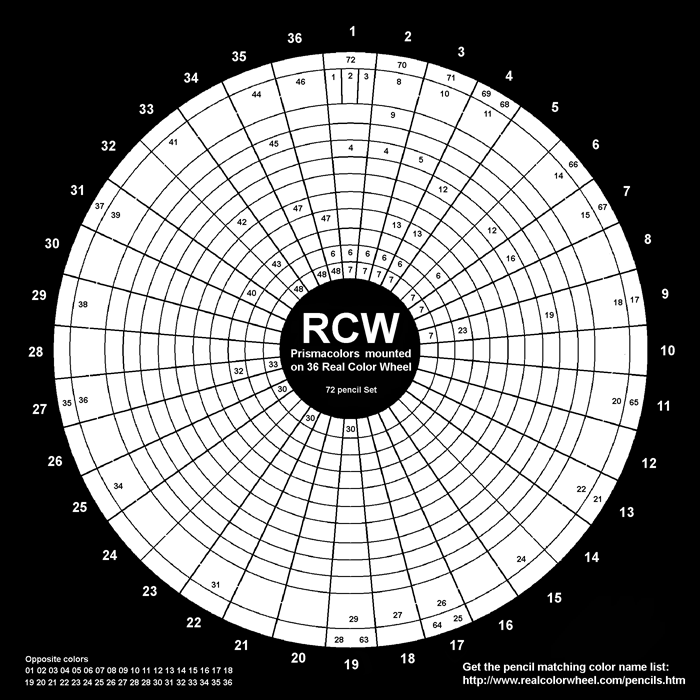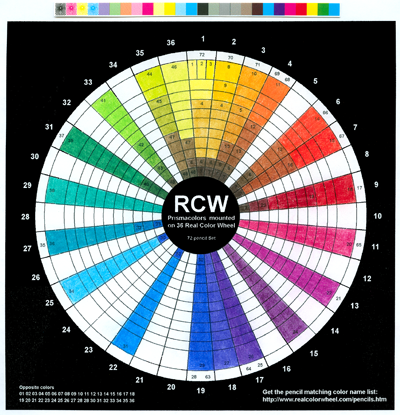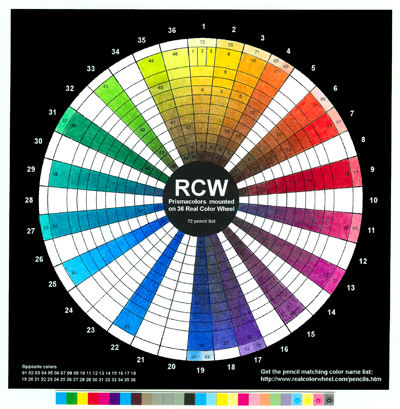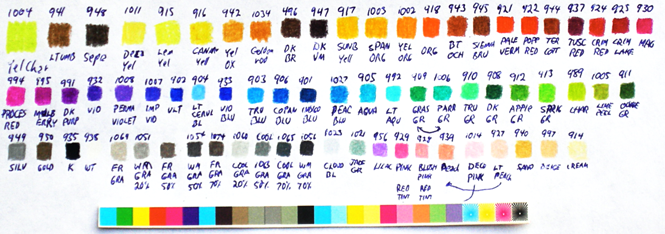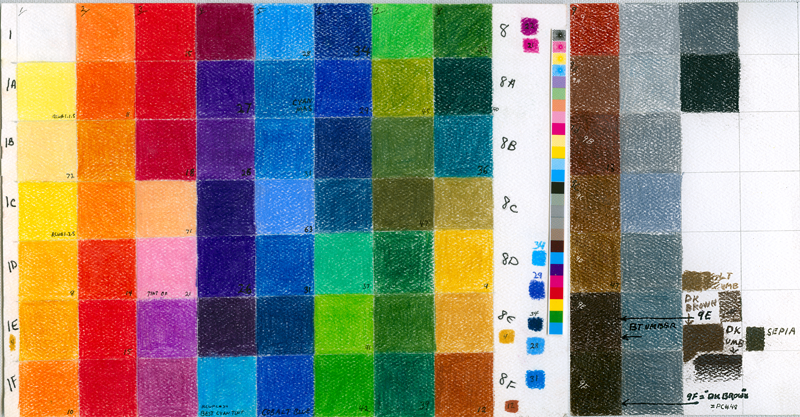|
Prismacolor (PC) 72 color set includes: 48 chroma colors, 11 tints, 13 non-color. Here they are colored on the 36 Real Color Wheel. 4-5-7, plus one extra added pencil/color, Prismacolor's PC919 Non-Photo Blue as a tint of Cyan. Print copies of this blank color wheel for your testing when making RCW complementary and split-complementary color schemes.
To get a printable 36 RCW Color Wheel blank 7" templet to print and color in, click this link:
Printable 36 Color Wheel, blank colorwheel
36RCW Colors: Primary= 36RCW#1 is Yellow, 36RCW#13 is Magenta, 36RCW#25 is Cyan. (Tip) Remove the Indigo Blue pencil PC901, and replace it with PC919 Non-photo Blue. This cyan color does not come with this 72 color set but it is very important. RCW's Three Set Numbering System:
Value: 10 shadow blocks down to neutral dark, 10 tint blocks up to white. The 3 Primary colors are equally separated by 120 degrees on a circle of 360 degrees. #1 is yellow, #13 is magenta and #25 is cyan. To color in the outer 10 blocks, blend each of these double diget colors evenly to white. Each 10 degree block of color starts as the pure mass-tone opaque tube color or a relative tint of the transparent color #1.0.
Cyan's transparent gradient colors are from the transparent mass-tone 36RCW#25.6 to the pure top-tone #25.0 to the lightest tint RCW#25.09. RCW#25.0 goes to the darkest shade RCW#25.9.
All colors on the exact other side of the color wheel are opposite and mix to a neutral dark. Yellow RCW#1 to Red RCW#7 all have a simular phenomenon. Colors from RCW#1 to RCW#7 all darken to red's RCW#7.10, dark just the same way as cyan RCW#25 darkens to blue's dark RCW#19.10. Seven opposite colors all darken to two major darks, brown and blue. Yes, Indian yellow does come in brown but it's not made into a pigment yet (11-16-12). The Japanese made a synthetic car paint that has the sun effects cyan to blue and yellow to brown but it's not available in a dry pigment. How to read this palette list.
C l i c k a b l e A r t i s t s R e a l C o l o r W h e e l : f i n d m a t c h i n g p i g m e n t s
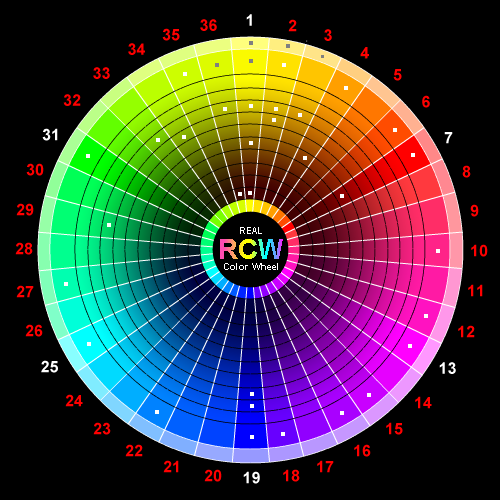
match the color to a RCW.
I make watercolors with a transparent yellow from Spectra Colors Corp in New Jersey. This transparent yellow Azo pigment is called Tartrazine, PY100, and it didn't fade or turn brown after 6 months on my dashboard in the Lahaina sun. "Lahaina" means the Land of the Burning Sun. I tubed another batch on 11-16-12. Pencils and Pastels and crayons need pressure and lighter colors are not generally made with less pressure, it takes another pencil as pastels use another color. Magenta, PR:122 is Prismacolor's #995 called Mulberry. This is a full hue magenta that in watercolors would be thinned down to make pink. In pencil use #994 called Process Red as the lighter tint of magenta. Both make good darks with green (#909 Grass Green). Prismacolor 1003 Spanish Orange is a dual-toned pencil. Light rubbing with is will give a lighter hue of yellow. It shows up more with an alcohol wash. Prismacolor PC922 Poppy Red needs more red in it I think, cadmimum red light would be the natural pigment to use. Prismacolor's PC903, called True Blue, pencil#31 has too much magenta in it, it's closer to cobalt blue hue. Maybe there is a better match in a larger set but for now I'm moving it to Cobalt Blue's spot, RCW#22. Let me explain my thoughts. Cyan is a transparent color, someday it will be dual-toned with a dark ultramarine blue like yellow is with brown. When using the opaque pencil cyan, it darkens with ultramarine blue, like the sky. Comparing the darkest browns;
Prismacolor has 3 dark browns, a magenta side brown RCW#10.10.5, a green side brown RCW#33.10.5 and a yellow side brown RCW#1.8.1. Normally Raw umber is a yellow-green side brown. Burnt umber is normally a red side brown. Prismacolor's Dark Brown is really a lighter burnt umber, a handy color. Dick Blick has 2 dark browns, a red side and a yellow side. Those are the normal burnt umber and raw umber. Dick Blick calls them Bt Umber and Dk Brown.
Here is a link that opens a zip file of a tif 36 RCW with out the numbers. Printable 36 Color Wheel, blank colorwheel |
||||||||||||||||||||||||||||||||||||||||||||||||||||||||||||||||||||||||||||||||||||||||||||||||||||||||||||||||||||||||||||||||||||||||||||||||||||||||||||||||||||||||||||||||||||||||||||||||||||||||||||||||||||||||||||||||||||||||||||||||||||||||||||||||||||||||||||||||||||||||||||||||||||||||||||||||||||||||||||||||||||||||||||||||||||||||||||||||||||||||||||||||||||||||||||||||||||||||||||||||||||||||||||||||||||||||||||||||||||||||||||||||||||||||||||||||||||||||||||||||||||||||||||||||||||||||||||||||||||||||||||||||||||||||||||||||||||||||||||||||||||||||||||||||||||||||||||||||||||
